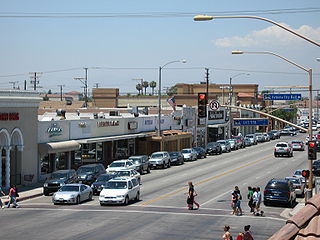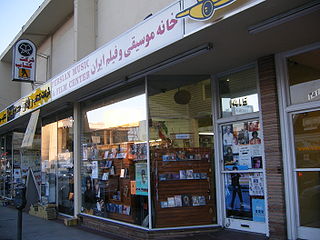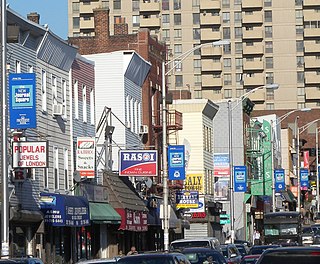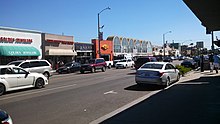
Artesia is a city in southeast Los Angeles County, California. Artesia was incorporated on May 29, 1959, and is one of Los Angeles County's Gateway Cities. The city has a 2010 census population of 16,522. Artesia is surrounded on the west, south, and east sides by Cerritos, with Norwalk to the north. Artesia is the home of the East West Ice Palace, an ice rink which is co-owned by Michelle Kwan. It was also the childhood home of former First Lady Pat Nixon, who lived there from 1914 to 1931, though the property on which she grew up is now part of neighboring Cerritos.

Koreatown is a neighborhood in central Los Angeles, California, centered near Eighth Street and Irolo Street.

Little Saigon is a name given to ethnic enclaves of expatriate Vietnamese mainly in English-speaking countries. Alternate names include Little Vietnam and Little Hanoi, depending on the enclave's political history. To avoid political undertones due to the renaming of Saigon to Ho Chi Minh City, it is occasionally called by the neutral name Vietnamtown. Saigon is the former name of the capital of the former South Vietnam, where a large number of first-generation Vietnamese immigrants arriving to the United States originate, whereas Hanoi is the current capital of Vietnam.

Tehrangeles is a portmanteau deriving from the combination of Tehran, the capital of Iran, and Los Angeles. A Persian community developed in Westwood, Los Angeles after the Islamic Revolution of 1979 prompted thousands of Iranians to flee to the United States. It is a shopping, eating and gathering place for the large number of Iranian-Americans and their descendants residing in the Los Angeles metropolitan area which is the largest such population outside Iran. The intersection of Westwood Boulevard and Wilkins Avenue was recognized by the City of Los Angeles as Persian Square.

A Koreatown, also known as a Little Korea or Little Seoul, is a Korean-dominated ethnic enclave within a city or metropolitan area outside the Korean Peninsula.

A Little Manila, also known as a Manilatown or Filipinotown, is a community with a large Filipino immigrant and descendant population. Little Manilas are enclaves of Overseas Filipinos consisting of people of Filipino origin living outside of the Philippines.

Thai Town is a neighborhood in Central Los Angeles, California. In 2008, it was one of the five Asian Pacific Islander neighborhoods in the city that received federal recognition as a Preserve America neighborhood. It is the only officially recognized Thai Town in the United States.

Little Tokyo, also known as Little Tokyo Historic District, is an ethnically Japanese American district in downtown Los Angeles and the heart of the largest Japanese-American population in North America. It is the largest and most populous of only three official Japantowns in the United States, all of which are in California. Founded around the beginning of the 20th century, the area, sometimes called Lil' Tokyo, J-Town, Shō-Tōkyō (小東京), is the cultural center for Japanese Americans in Southern California. It was declared a National Historic Landmark District in 1995.

Little India is an Indian or South Asian sociocultural environment outside India or the Indian subcontinent. It especially refers to an area with Indian residences and a diverse collection of Indian businesses. Frequently, Little Indias have Hindu temples, mosques, and gurdwaras. They may also host celebrations of national and religious festivals and serve as gathering places for South Asians. As such, they are microcosms of India. Little Indias are often tourist attractions and are frequented by fans of Indian cuisine, Indian culture, Indian clothing, Indian music, and Indian cinema.

The Asian-American influx to the San Gabriel Valley grew rapidly when Chinese began settling in Monterey Park, California, in the western San Gabriel Valley in the 1970s. Just east of Los Angeles, the region has achieved international prominence as a hub of overseas Chinese, or hua qiao. Although Chinese immigrants were a noteworthy presence in the establishment of Southern California from the 19th century, significant Chinese migration to suburban San Gabriel Valley coincided with a trend of white out-migration from the 1970s onward. This opened an opportunity for middle-class Asian Americans to begin settling in the San Gabriel Valley.

The Great American Boycott, also called the Day Without an Immigrant, was a one-day boycott of United States schools and businesses by immigrants in the United States which took place on May 1, 2006.

India Square, also known as "Little India," is a commercial and restaurant district in the Journal Square and Marion Section neighborhoods of Jersey City, New Jersey, US.
Little Arabia is an ethnic enclave in western Anaheim, California, the center for Orange County's Arab Americans, who number more than 24,000. It has been referred to as "Little Gaza" which was a riff on the nearby Garza Island neighborhoods. Little Arabia grew significantly in the 1990s with the arrival of immigrants from the Middle East, and is the home to thousands of Arab Americans predominantly hailing from Egypt, Syria, Palestine, and Yemen.
Artesia Boulevard is a west-east thoroughfare in Los Angeles County and Orange County.

Little Pakistan is a general name for an ethnic enclave populated primarily by Pakistani immigrants and people of Pakistani ancestry, usually in an urban neighborhood all over the world.

Chinatowns are enclaves of Chinese people outside of China. The first Chinatown in the United States was San Francisco's Chinatown in 1848, and many other Chinatowns were established in the 19th century by the Chinese diaspora on the West Coast. By 1875, Chinatowns had emerged in eastern cities such as New York City, Boston, and Philadelphia. The Chinese Exclusion Act of 1882 barred Chinese immigration to the United States, but the Magnuson Act of 1943 repealed it, and the population of Chinatowns began to rise again. In the 2010s, the downturn in the U.S. economy caused many Chinese Americans to return to China.

As of 2008, the sixty thousand ethnic Koreans in Greater Los Angeles constituted the largest Korean community in the United States. Their number made up 15 percent of the country's Korean American population.
The 1990 United States census and 2000 United States census found that non-Hispanic whites were becoming a minority in Los Angeles. Estimates for the 2010 United States census results find Latinos to be approximately half (47-49%) of the city's population, growing from 40% in 2000 and 30-35% in 1990 census.
Greater Los Angeles has the second-largest Indian American population in California, following the San Francisco Bay Area. As of 2015, there are 153,000 Indian Americans in greater Los Angeles and Indian Americans make up the fifth-largest Asian ancestry group in the metropolitan area Indian immigrants started to move to the suburbs areas of Southern California after the passage of the 1965 Hart-Celler Immigration Act, with a concentration of businesses in the southeastern Los Angeles County suburb of Artesia, California.













